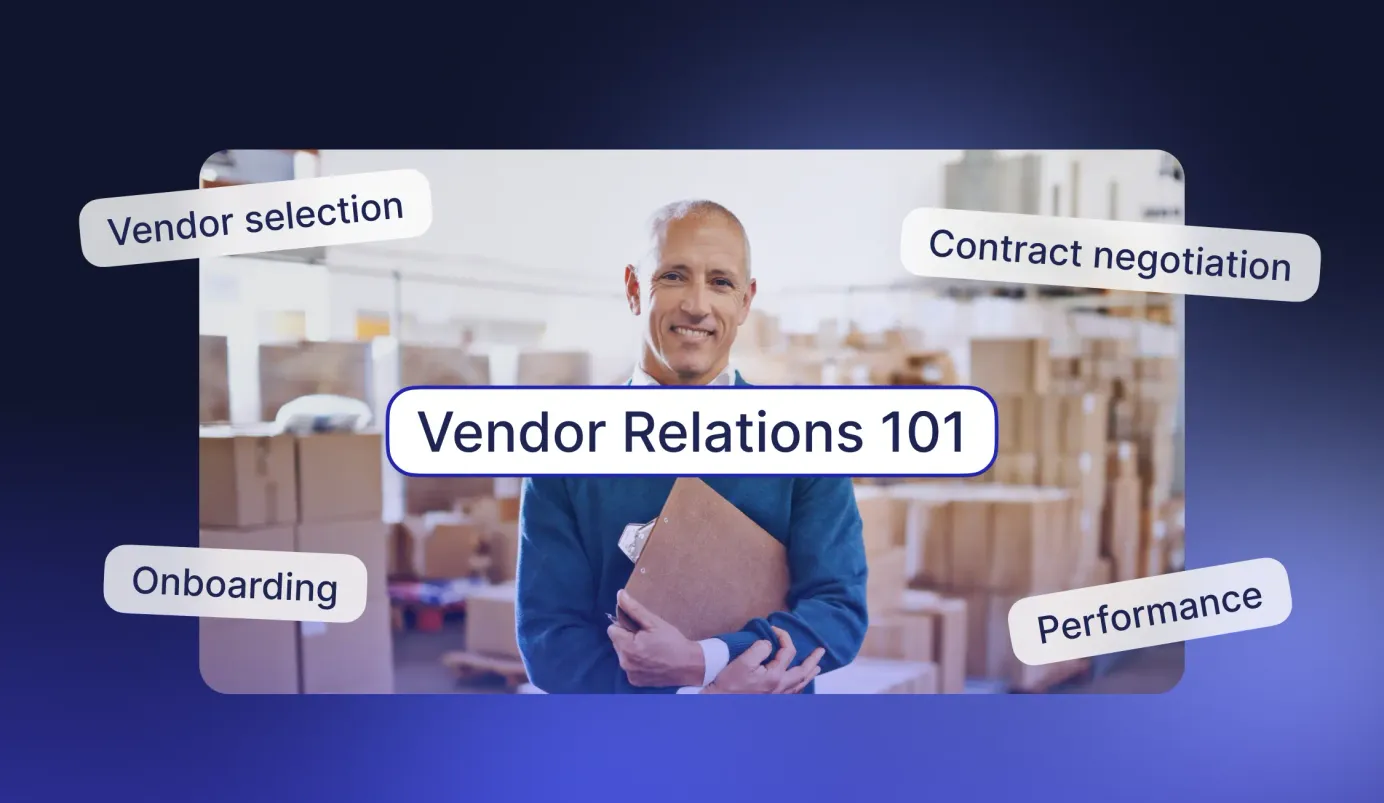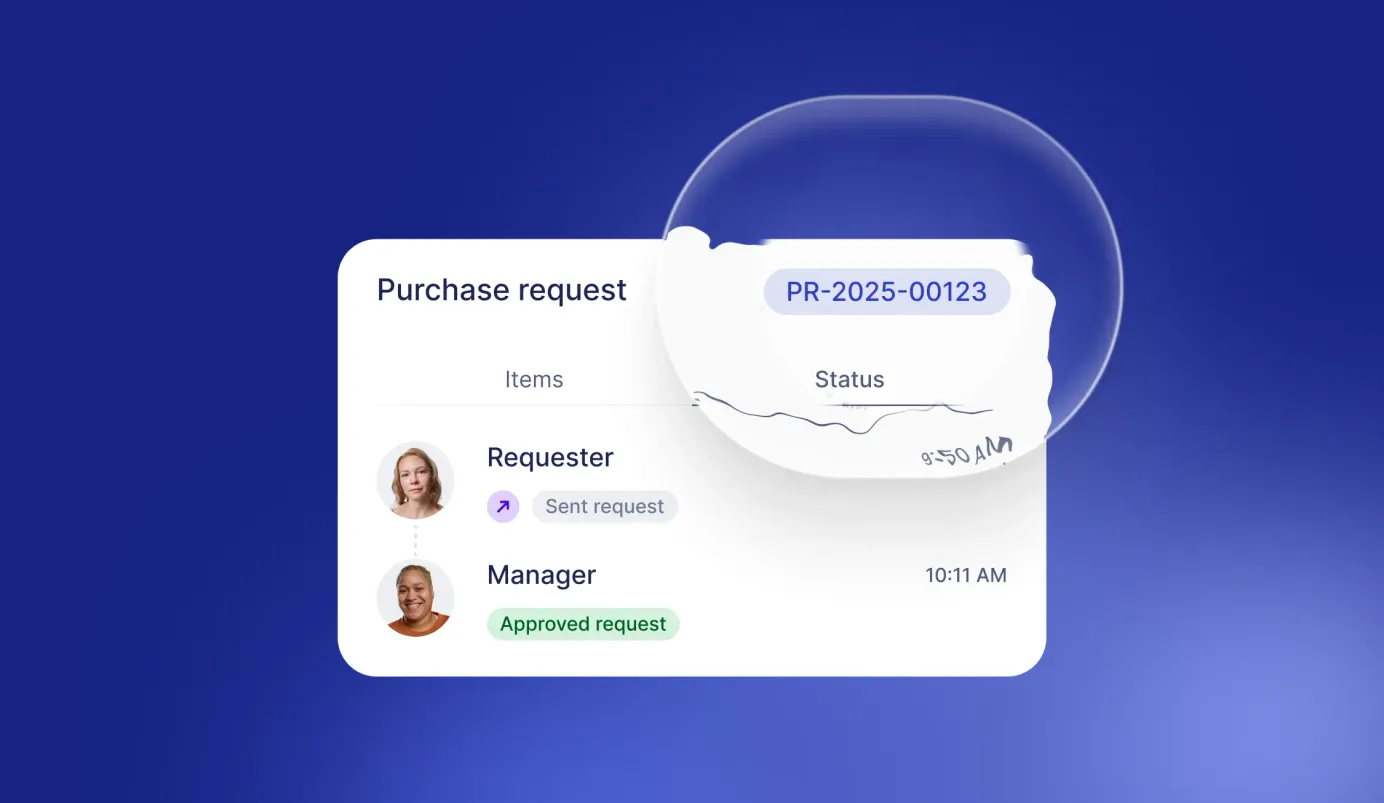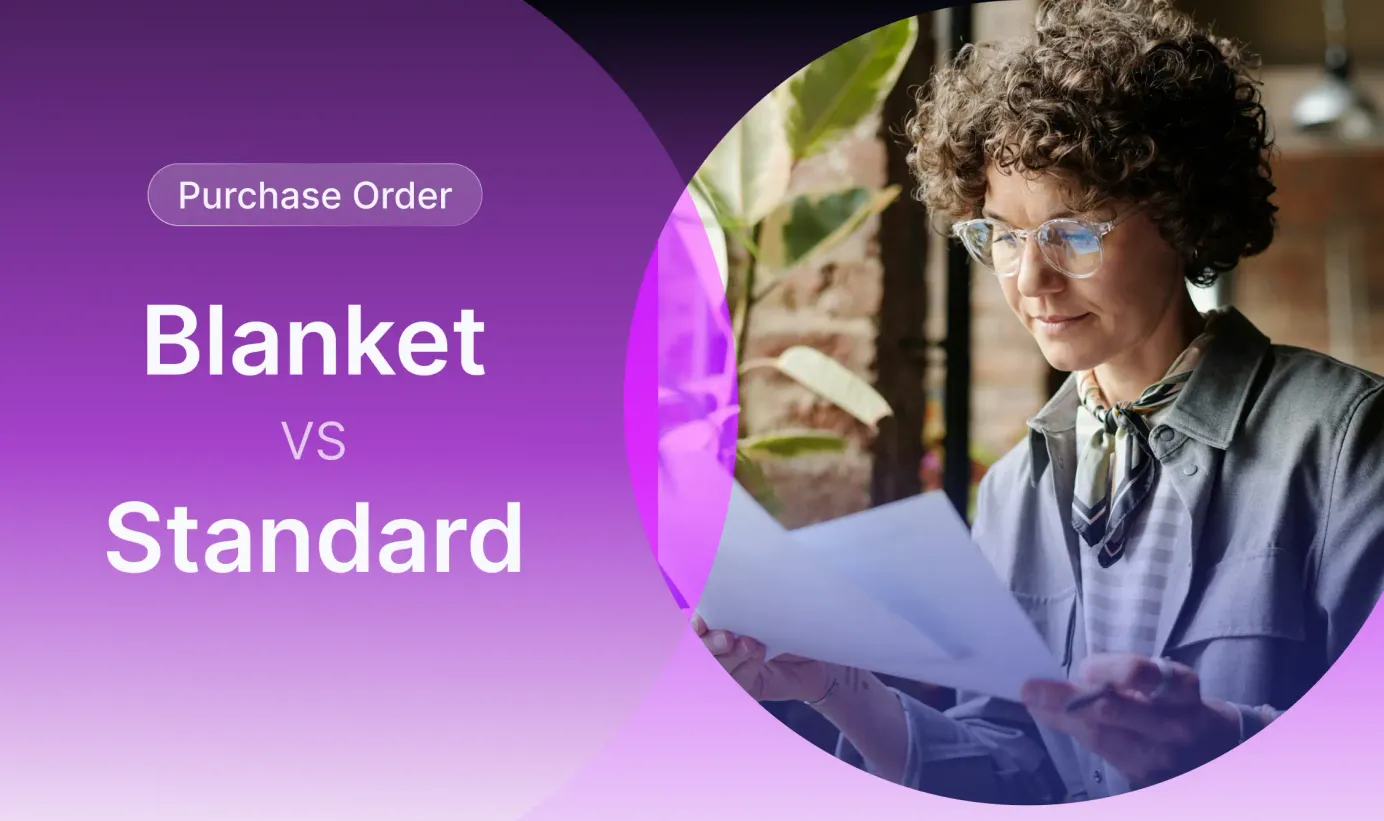
14 min read
Blanket PO vs. Standard PO: Guide For Recurring Purchases [2025]
Streamline recurring purchases. Unlock the potential of blanket PO and standard purchase orders with our comprehensive guide.
The efficiency of B2B transactions stems from the strategic use of purchase orders in procurement workflows. These documents not only clarify communication between parties but also establish a framework for vendor management and cost optimization, ensuring smooth business operations.
The choice between blanket purchase orders and standard POs can make or break your business's procurement strategy. For growing companies, understanding these two distinct ordering systems isn't just about paperwork — it's about streamlining operations and cutting costs where it matters most.
Below, we’ve broken down the definitions of both PO types, including recommendations for using blanket PO vs. standard PO, with benefits and drawbacks analyzed. This will help you make smart choices for your recurring purchases.
Scroll down to find out:
What is a Standard Purchase Order?
When to Use a Standard Purchase Order
When Not to Use a Standard Purchase Order
What is a Blanket Purchase Order?
When to Use a Blanket Purchase Order
When Not to Use a Blanket Purchase Order
What is the Difference Between Standard and Blanket Purchase Orders?
Pros and Cons of a Standard PO
Pros and Cons of a Blanket PO
Best Practices for Managing Blanket Purchase Orders
Frequently Asked Questions About Blanket PO vs. Standard PO
What is a Standard Purchase Order?
A Standard Purchase Order (SPO) is a formal business document that outlines a single transaction between buyer and supplier, detailing specific products, quantities, and prices. This type of PO is often used when a business purchases goods or services on a one-time basis or when a company has a short-term agreement with a vendor. This document serves as a legal framework for the transaction, protecting both parties' interests through clearly defined obligations.
Examples: A hotel furniture set, catering at a milestone event, office computers, and capital renovation services.
What’s Included in a Standard Purchase Order?
A comprehensive standard purchase order typically contains the following:
- Unique PO number for tracking.
- Issue date and expected delivery date.
- Buyer's and seller's complete contact information.
- Detailed description of goods or services.
- Quantity and unit price.
- Payment terms and conditions.
- Shipping method and delivery instructions.
- Quality specifications and acceptance criteria.
- Terms and conditions of purchase, discounts.
When to Use a Standard Purchase Order
Standard purchase orders are most appropriate in the following scenarios:
- One-time purchases of specific items.
- When exact quantities and delivery dates are known.
- For non-recurring or irregular purchases.
- When dealing with new suppliers.
- For purchases requiring detailed specifications.
- When full payment terms need to be documented.
When Not to Use a Standard Purchase Order
Standard POs may not be the best choice in these situations:
- Recurring purchases from the same supplier.
- When quantities or delivery schedules are flexible.
- For long-term supplier relationships requiring regular orders.
- When pricing may fluctuate over time.
- For high-volume, routine purchases.
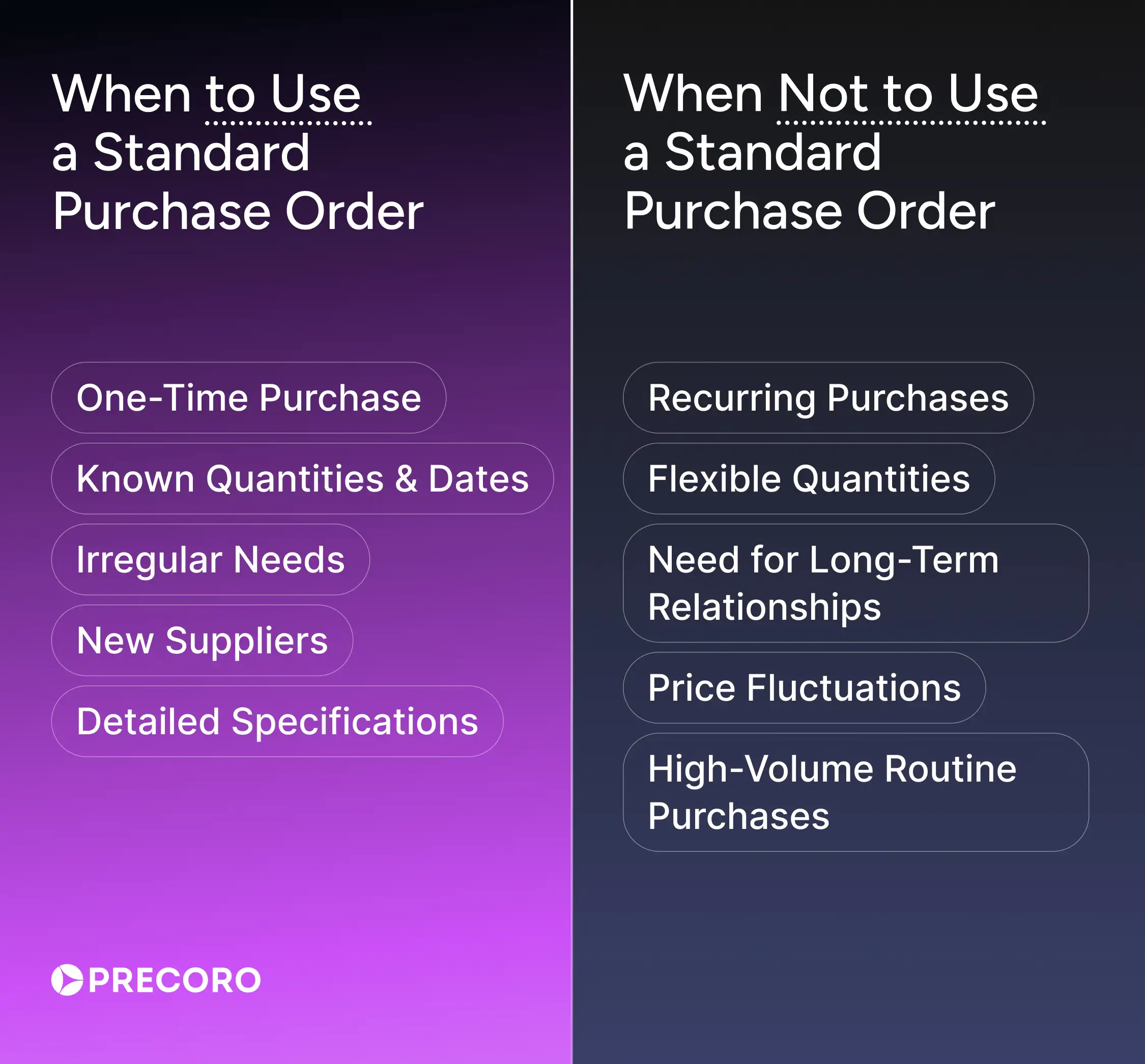
What is a Blanket Purchase Order?
A blanket purchase order (BPO) is a long-term agreement between a buyer and supplier that allows multiple deliveries or services over a specified period, typically a year. It establishes terms, conditions, and pricing upfront while leaving the exact delivery schedules and quantities flexible. Also, by definition, a blanket PO is often called a blanket agreement and a standing/frame/call-off order. A BPO is designed to satisfy the organization’s recurring need for goods or services.
Examples: Regular office cleaning services, daily water delivery, raw materials for a construction project, scheduled tech maintenance and repair.
What's Specified in a Blanket Purchase Order?
Apart from the details characteristic of a normal PO, a standing purchase order contains the following information:
- Contract duration (usually one year).
- Multiple delivery schedules.
- Fixed unit or periodic price (for goods or services, respectively).
- Total expected quantity or value.
- Delivery terms and locations.
- Quality and size specifications.
- Payment terms.
- Minimum and maximum order quantities.
- Total costs for the length of the contract.
When to Use a Blanket Purchase Order
A blanket PO in SAP is ideal when you:
- Have recurring needs for specific items or services.
- Want to secure fixed pricing for an extended period.
- Need regular deliveries but can't specify exact timing.
- Want to reduce administrative work for repeat purchases.
- Have a reliable supplier relationship.
- Need standardized products that require multiple shipments.
When Not to Use a Blanket Purchase Order
Avoid blanket POs when:
- Prices are volatile or likely to decrease significantly/are unknown at the time of purchase.
- Requirements are uncertain or one-time.
- Supplier reliability is unproven.
- When the terms are subject to change by the seller without notice.
- Quality standards vary frequently.
- Budget constraints require strict purchase controls.
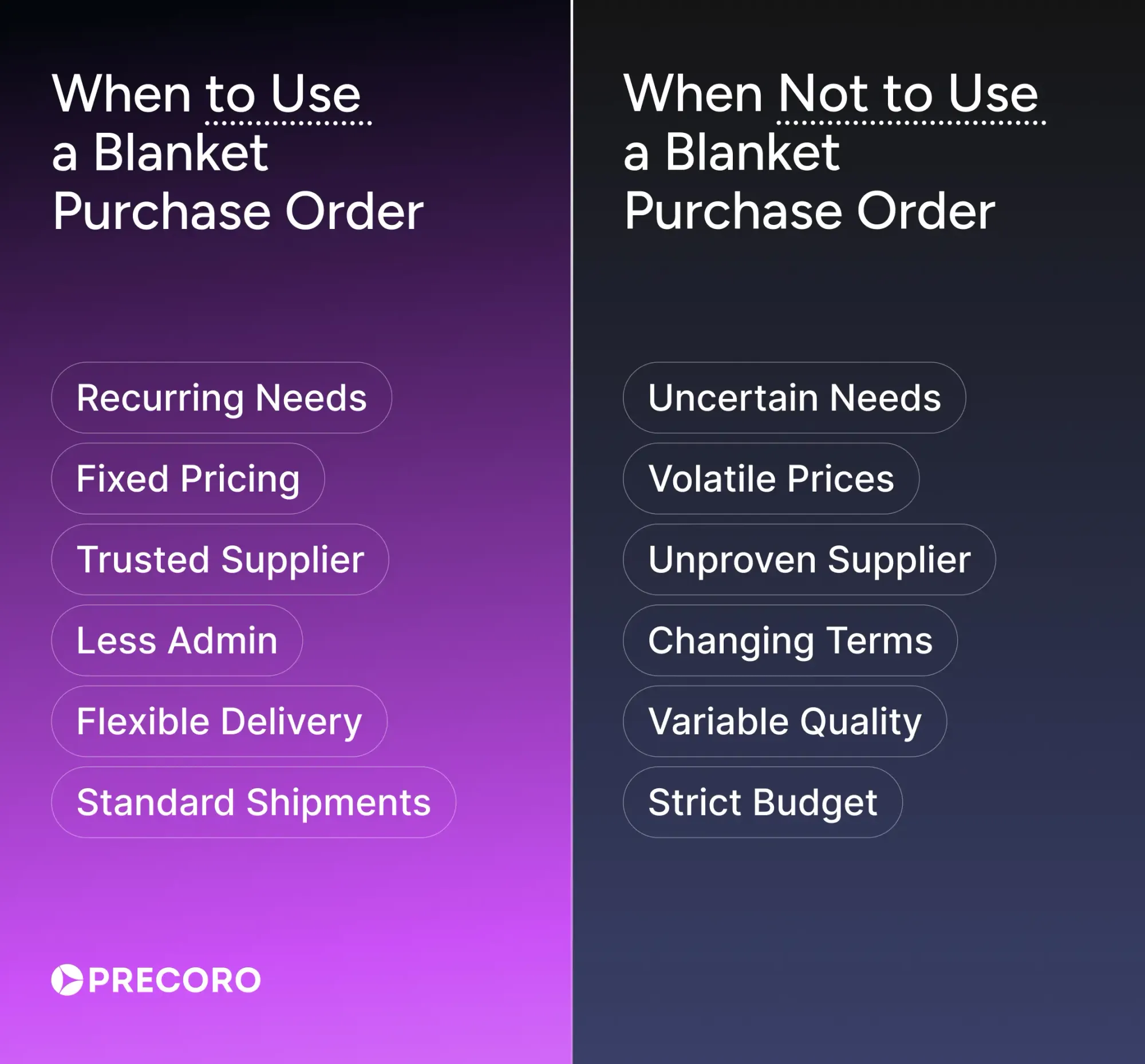
Smart procurement relies on understanding different PO types. Yet theory can't go alone without practice.
Since we defined what is a blanket purchase order and described the ins and outs of a standard purchase order — learn practical steps on How to create a purchase order and the detailed showcase of How to create a blanket purchase order in our knowledge base.
While these processes typically take a lot of time when done manually, in Precoro, both types of POs can be created with just a few simple clicks.

What is the Difference Between Standard and Blanket Purchase Orders?
Now, let’s take a closer look at the differences between standard and blanket purchase orders.
Timeframe and Duration
- Blanket PO: Designed for long-term agreements, typically spanning a year or a quarter, with defined start and end dates. It’s suitable for recurring purchases where a continuous need exists. The contract length is a key differentiator.
- Standard PO: Used for short-term or one-time purchases to fulfill a specific order. The PO is closed once the transaction is complete.
Level of Detail
- Blanket PO: Tends to be generic, providing high-level purchase details and focusing on broad needs rather than specifics like part numbers. Multiple deliveries can be accommodated within the BPO.
- Standard PO: A detailed order that includes comprehensive information on the materials or services, specifying exact quantities and delivery times.
Pricing Structures
- Blanket PO: Prices are typically locked in for the agreement's duration, securing a fixed rate and avoiding market fluctuations. Cost savings are a key advantage.
- Standard PO: Prices are often negotiable and vary with each order, allowing businesses to leverage market conditions.
Flexibility in Terms and Conditions
- Blanket PO: It’s generally less flexible because it involves a long-term commitment with pre-agreed terms. Modifying these terms often requires renegotiation.
- Standard PO: Offers more flexibility, enabling unique terms and conditions for each order. Adjusting quantities or delivery schedules is easier.
Paperwork and Administration
- Blanket PO: Typically involves less paperwork since it consolidates multiple orders into a single agreement, streamlining procurement processes.
- Standard PO: This usually results in more paperwork because each order requires a separate purchase order, which can increase administrative tasks. However, standard POs allow for detailed tracking of individual transactions.
Volume and Deliverables
- Blanket PO: Involves a higher volume of orders than a single PO. It is more often used for services with recurring demand.
- Standard PO: Used for a single, fixed quantity with a specific delivery date.
Note!
Long-term needs favor blanket POs for locked pricing and reduced paperwork through consolidated ordering. On the other hand, standard POs are better suited for short-term agreements, as they allow for frequent adjustments to quantities, terms, costs, and quality control.
Pros and Cons of a Standard PO
Though well-established in business practice, this purchase order method comes with various pros and cons that demand thoughtful organizational review.
Benefits of SPO
Standard purchase orders offer several advantages for businesses:
Control and Precision.
They provide detailed control over each purchase, allowing businesses to specify exact requirements and expectations. This precision helps ensure quality standards are met and reduces misunderstandings between parties.
Legal Protection.
Regular POs serve as legally binding contracts that outline the terms of the transaction, including pricing, delivery dates, and quantities. This legal framework protects both parties in disputes, providing tangible evidence of the agreed-upon terms.
Negotiation Flexibility.
Each purchase can be negotiated independently, allowing businesses to adjust terms based on current market conditions or changing needs. This flexibility can be particularly valuable in volatile markets or when dealing with customized orders.
Improved Budgeting.
Purchase orders help businesses track and control their expenditures by providing a clear overview of upcoming expenses. This facilitates accurate spend tracking and enables informed decision-making regarding budget allocations.
Efficient Record Keeping.
Standard POs create a clear paper trail for accounting, auditing, and legal purposes. They help track spending, maintain budget control, and provide evidence of authorized purchases.
Clarity and Reduced Errors.
By specifying exact requirements in each PO, businesses can maintain consistent quality standards and hold suppliers accountable for meeting these standards.
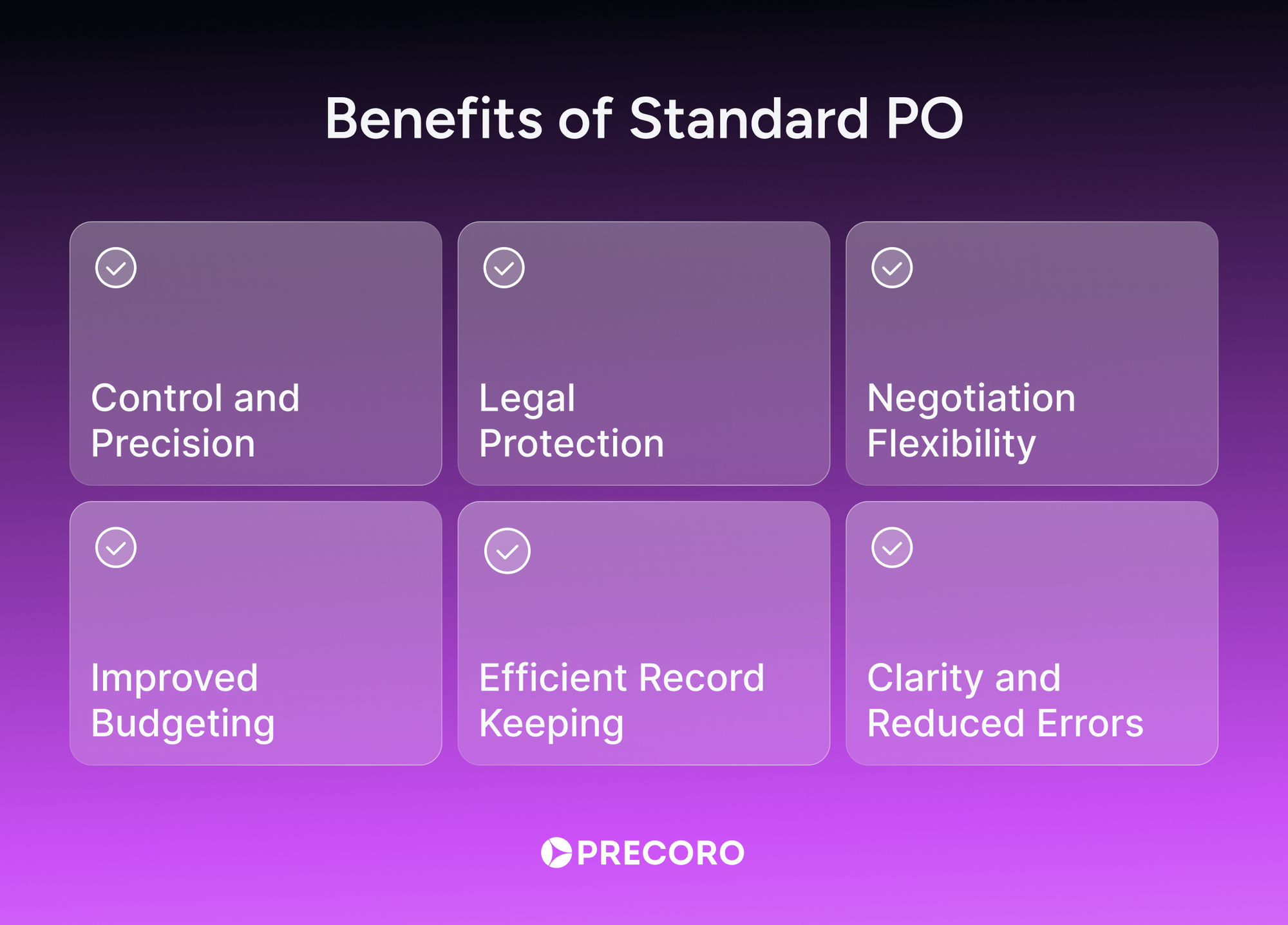
Disadvantages of Standard PO
Despite their benefits, standard purchase orders have several limitations:
Higher Administrative Burden.
Processing individual POs for recurring purchases increases paperwork and administrative overhead. This can lead to increased processing time and higher operational costs.
Pricing Variability.
Without long-term agreements, prices may fluctuate with each order. This can make budgeting more challenging and potentially result in higher costs over time.
Time-Intensive Process.
Each new purchase requires a complete procurement cycle, including approval processes, document preparation, and supplier communication. This can slow down the purchasing process and impact operational efficiency.
Limited Relationship Building.
The transaction-by-transaction nature of standard POs may not foster strong supplier relationships compared to long-term agreements like blanket POs.
Resource Allocation.
Managing multiple individual POs requires more staff time and attention, potentially diverting resources from other important tasks.
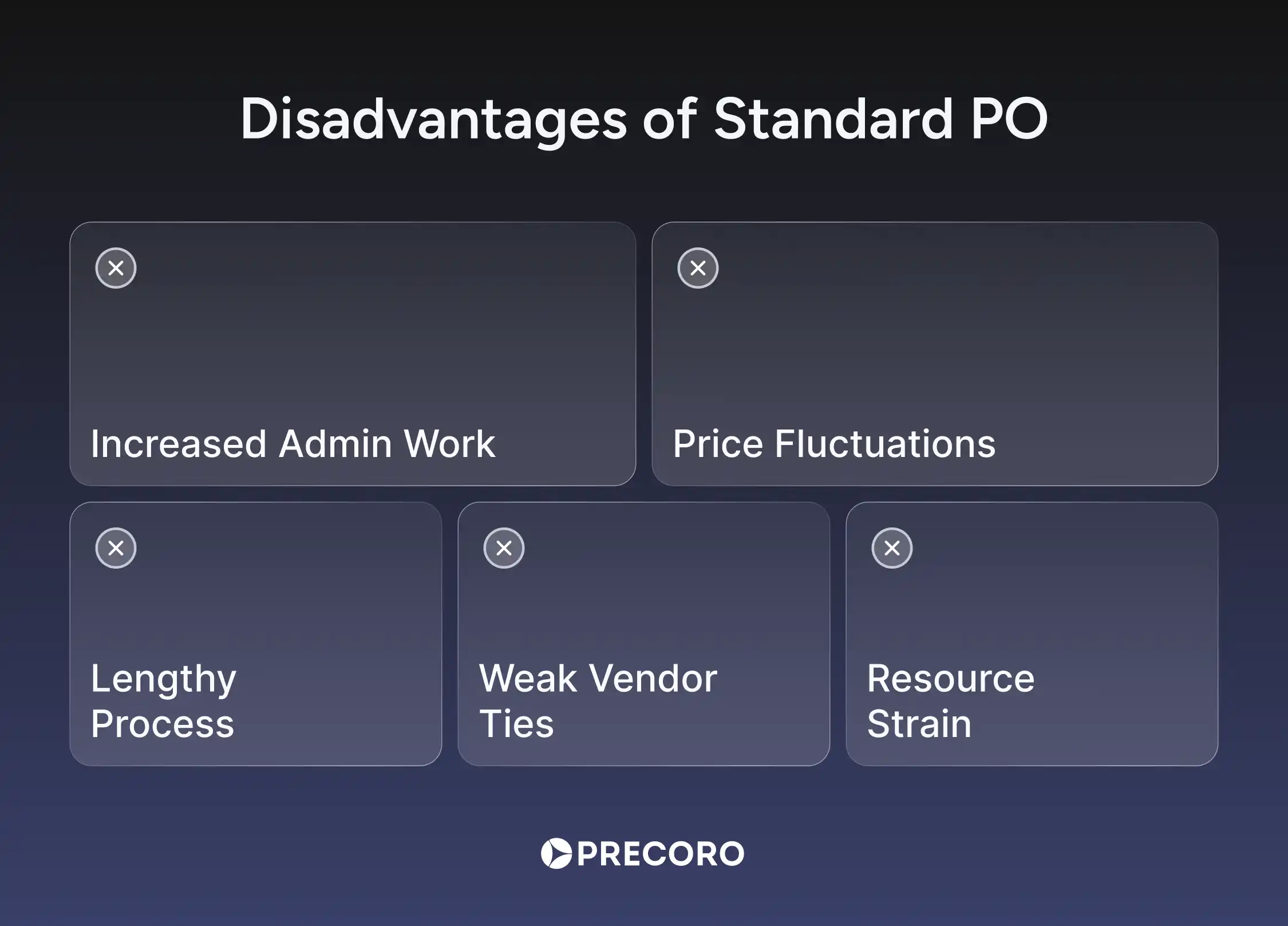
Pros and Cons of a Blanket PO
While blanket POs can significantly streamline procurement processes, they also have both pros and cons.
Benefits of Blanket PO
The benefits extend beyond simple cost savings, touching on operational efficiency, vendor relationships, and administrative productivity. Let's explore the key advantages that make blanket POs attractive for many businesses.
Easy To Set Up.
Setting up a blanket purchase order is extremely easy. Suppliers handle most of the processing, while your responsibility is to provide key details: the supplier's name, contract amount, funding account, and start and end dates.
"Hands-Off" Solutions for Growth.
Once you set up the blanket purchase order, you no longer need to worry about the ordering process each week or month. If the BPO has a set amount of money in the account, the service will continue uninterrupted until the money has all been used up.
Savings through Bulk Ordering.
A BPO contract can save costs if the market fluctuates, but buying in bulk can save a substantial amount immediately. Suppliers typically reward larger orders and longer-term commitments with better pricing. BPOs also reduce administrative overhead, cutting both costs and complexity.
Reduced Administrative Costs.
Each purchase order requires staff time, paperwork, and processing resources, costing organizations between $50-1000 per PO. Using blanket POs, companies can significantly reduce these administrative tasks by consolidating multiple invoices or orders into a single agreement. This reduction in PO invoice processing can lead to savings of up to 75% in administrative costs.
Guaranteed Pricing.
With a blanket PO, prices are locked in for the duration of the agreement, typically 12-24 months, protecting against market fluctuations and inflation. This price stability allows for more accurate cost projections and helps maintain consistent profit margins throughout the contract period.
Faster Ordering and Delivery.
Once a blanket PO is established, release orders can be processed in minutes rather than hours or days required for new POs. The pre-established terms eliminate negotiation delays, and suppliers often prioritize blanket PO customers, reducing delivery times.
Better Inventory Management.
Scheduled deliveries under blanket POs enable organizations to reduce safety stock levels and implement just-in-time inventory practices. Regular delivery schedules improve planning capabilities and reduce warehouse costs through optimized inventory levels.
Strengthened Supplier Relationships.
Long-term commitments through blanket POs foster stronger partnerships with suppliers, leading to better service levels and communication. These relationships often result in priority treatment, more reliable support, and earlier access to supplier innovations.
Simplified Budgeting and Forecasting.
Blanket POs provide predictable costs over extended periods, enabling more accurate budgeting and financial forecasting. Fixed pricing and committed volumes eliminate much of the uncertainty in financial planning and reduce budget variances.
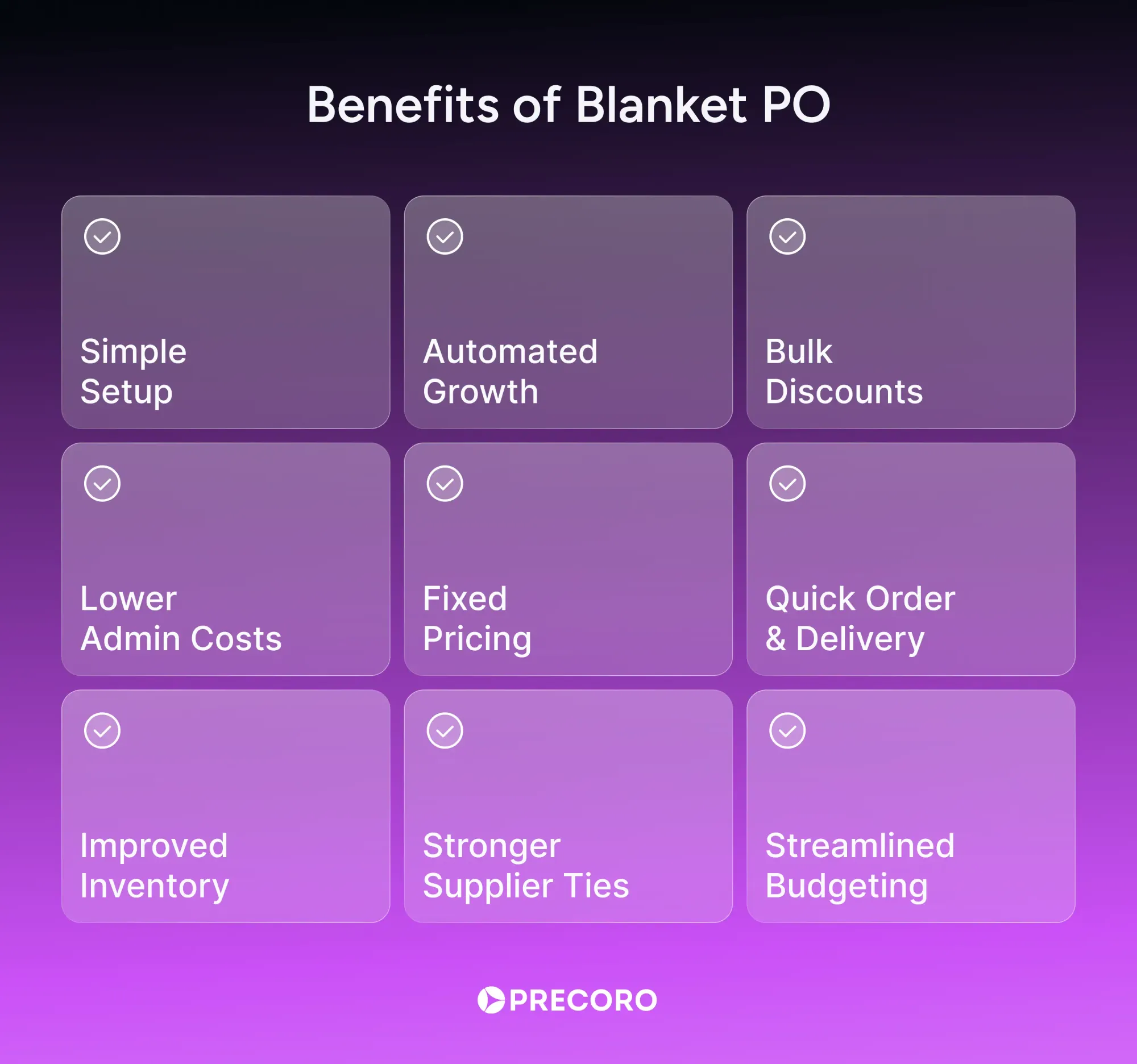
Disadvantages of Blanket PO
While Blanket Purchase Orders (BPOs) offer significant advantages in procurement, they also come with several potential drawbacks; check them below.
Less Flexibility to Switch Suppliers.
Organizations are typically locked into 12-month minimum commitments with specific suppliers, often with substantial early termination penalties. This commitment can prevent taking advantage of better offers from other suppliers and reduces negotiating leverage.
Risk of Over-Commitment.
Organizations must meet minimum purchase requirements regardless of changing business needs or market conditions. If demand decreases, companies must still fulfill their committed volumes or face penalties.
Potential for Unused Capacity.
When demand decreases, organizations may be forced to take delivery of and store excess inventory, leading to increased carrying costs and potential obsolescence. Storage costs typically range from 20-30% of inventory value annually.
Missing Market Price Decreases.
Fixed pricing in blanket POs means organizations cannot exploit market price drops or spot buying opportunities. Competitors not locked into long-term agreements may secure better pricing when market conditions are favorable.
Requires Careful Monitoring and Management.
Blanket POs require dedicated contract management, performance monitoring, and compliance tracking resources. Regular reviews and variance analyses are necessary to ensure both parties meet their obligations.
Can Lead to Complacency in Supplier Relationships.
Long-term agreements can reduce suppliers' motivation to improve service levels or seek cost reductions. Suppliers may become less responsive to quality issues or innovation needs without competitive pressure.
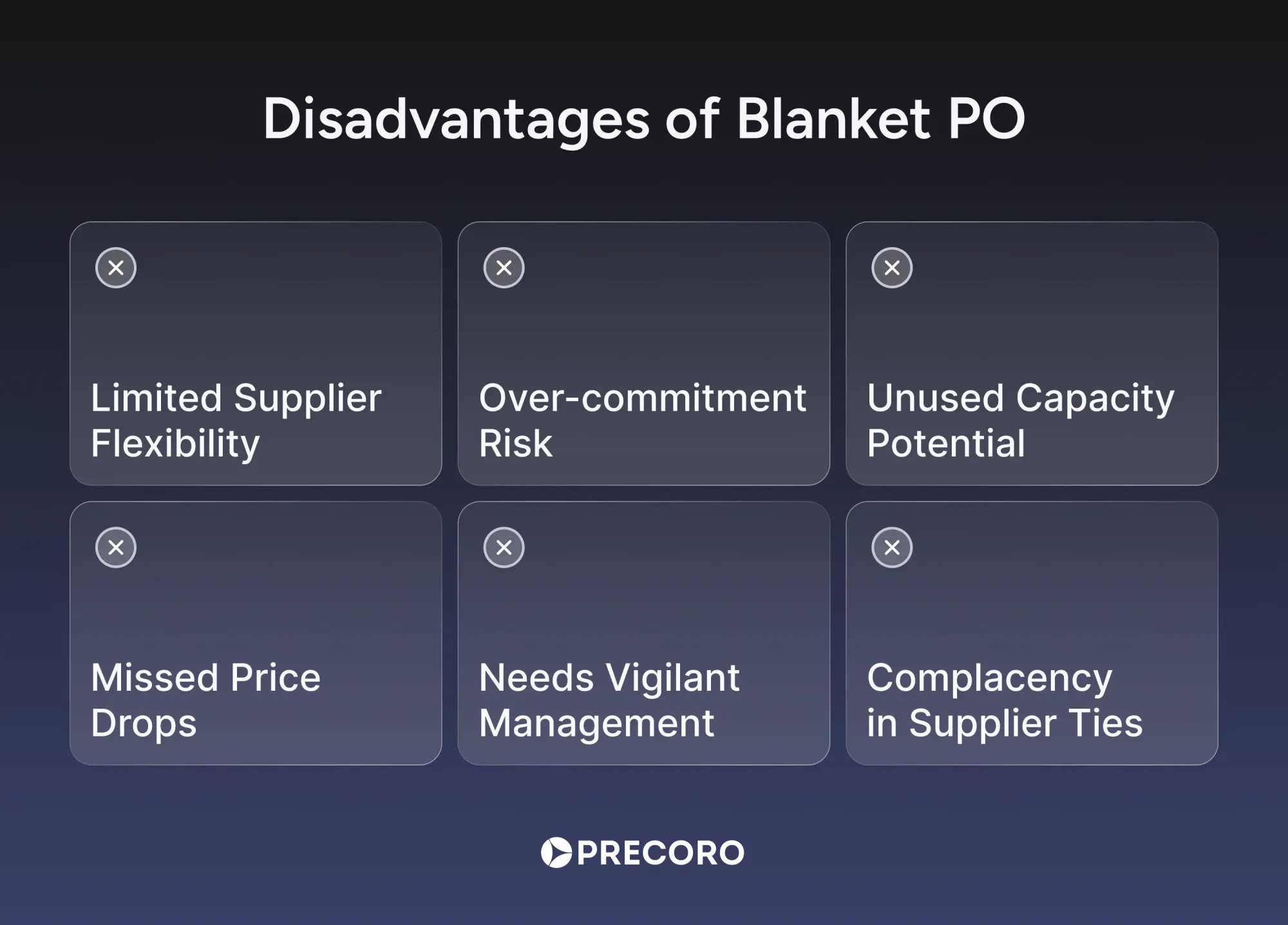
Best Practices for Managing Blanket Purchase Orders
To optimize blanket purchase orders and minimize risks, organizations should implement these comprehensive management practices:
Strategic Planning and Setup.
Establish clear trigger points for blanket POs based on spending analysis, typically when annual spend with a supplier exceeds $50,000 or involves more than 24 individual orders per year. Define precise specifications, including quality standards, delivery schedules, and minimum/maximum order quantities. Add flexibility clauses allowing volume adjustments (usually ±15-20%) based on market conditions.
Performance Monitoring Systems.
Implement regular quarterly supplier performance reviews, tracking key metrics like delivery compliance, quality standards, and pricing competitiveness. Additionally, use automated systems to monitor spend patterns and ensure purchases stay within contracted limits. To prevent overruns or shortfalls, set up automated alerts for when spending reaches 70-80% of committed volumes.
Financial Controls.
Establish a multi-tier approval workflow for blanket POs, where different authorization levels are required based on the order value. Maintain detailed spend tracking with monthly reconciliation against budgets. You could also create separate cost centers for tracking blanket PO expenditures to ensure accurate financial reporting and analysis.
Supplier Relationship Management.
Schedule quarterly business reviews with key suppliers to discuss performance, market conditions, and improvement opportunities. Maintain open communication channels through designated relationship managers. It’s a good idea to document all interactions and changes to the agreement, ensuring both parties remain aligned on expectations and commitments.
Risk Management.
Diversify supplier base by limiting blanket PO commitments to no more than 40% of total category spend with any single supplier. Include market adjustment clauses for long-term agreements (over 12 months) to protect against significant market price variations. Also, maintain contingency plans for supplier disruptions or performance issues.
Continuous Improvement.
Conduct annual reviews of blanket PO effectiveness, comparing actual savings against projections. Use data analytics to identify optimization opportunities in order quantities and delivery schedules. Moreover, regularly benchmark pricing against market rates to ensure the continued competitiveness of the agreement.
Frequently Asked Questions About Blanket PO vs. Standard PO
Blanket POs typically save more money through volume discounts, reduced administrative costs, and locked-in pricing. Meanwhile, standard POs are better for one-off purchases or when prices are volatile. The cost savings from blanket POs are especially significant when considering the reduced time and effort spent processing multiple individual orders.
Blanket POs better support scaling operations by providing flexibility and guaranteed supply at predetermined prices, making expanding into new markets with predictable costs easier. Standard POs can make scaling more challenging since each new location or market expansion requires negotiating and processing separate purchase orders.
In short, Blanket POs work best for large, repeat orders over time. Standard POs are better for single purchases when you know exactly what you need.
Typically, blanket orders last 6-12 months. However, depending on the industry and the supplier's relationship, they can be extended up to several years. The duration is usually determined by market stability, supplier relationships, and the strategic importance of the materials being purchased.
Blanket POs protect companies from market fluctuations due to predetermined pricing. During periods of price volatility, standard POs may be preferable as they allow organizations to adjust pricing with each new order, while blanket POs lock in prices, which could be advantageous or disadvantageous depending on market trends. The choice often depends on whether you expect prices to rise (favoring blanket POs) or fall (favoring standard POs) during the contract period.
The right PO choice today can shape your business efficiency for years to come
B2B transactions are challenging. To keep on top of them, both procurement departments and suppliers require clear documentation and consistent financial management strategies. Otherwise, they risk failing to account for orders and making costly mistakes.
That’s where the purchase order management comes into play, keeping a record of ordered items and services, prices, stock, delivery dates, and other terms. POs benefit enterprises and small businesses by providing spend visibility and optimizing order processing.Choosing the appropriate purchase order type tailored to your organization’s goals is essential for procurement teams to provide optimal value. This helps to establish lasting relationships with cherry-picked vendors, forecast your inventory needs, and save time and money.While deciding between a standard and blanket purchase, consider the following:
- Are your orders primarily recurring?
- Do you order from the same reliable supplier?
- Would you like to place bulk orders with volume discounts?
- Does your vendor guarantee goods availability and quality in the long run?
If most of these points made you nod in agreement, a standing agreement or a BPO is right for you. If not, you should probably go with the universal standard order, which will tend to your short-term, irregular purchases with detailed fixed conditions. To bring your performance to an even higher level, benefit from state-of-the-art procurement platform like Precoro. An effective purchasing management tool safely keeps your purchase requests, orders, approvals, budgets, reports, and other vital data in one place, allowing you to focus on what matters.


